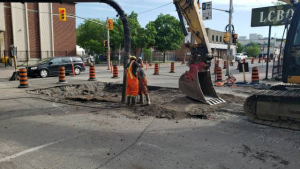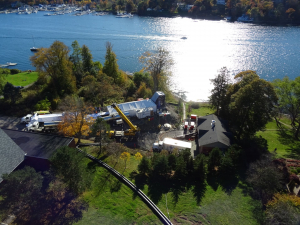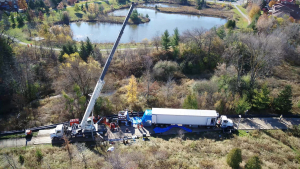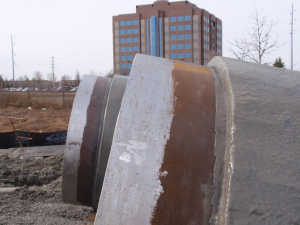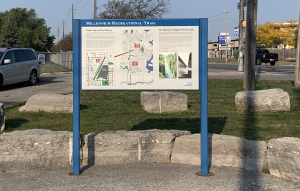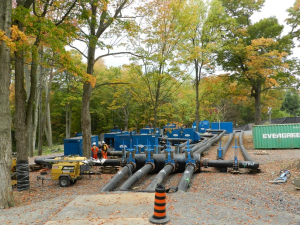Displaying items by tag: Construction
York-Peel Feedermain Emergency Repair
The Regional Municipality of York operates a significant water supply system, including approximately 360km of transmission watermain, to meet the demands of its population of over 1.2 million residents. The York-Peel feedermain, a critical watermain that supplies approximately 30% of the water demand for the Region, is comprised of 1,800mm (72in.) diameter pre-stressed concrete cylinder pipe (PCCP) constructed in 2005.
In 2022, as part of a leak detection inspection using SmartBall technology, the Region identified two leak points at Humber River crossings located within the Toronto Region Conservation Authority (TRCA) regulated area. The first leak was detected near the west portion of the Humber River near the intersection of Rutherford Road and Highway 27. The second location was east of the river, near Rutherford Road and Pine Valley Road. The west leak was severe with an estimated rate of 30L/s beneath the river and was in close proximity to the Rutherford Road bridge crossing.
In October 2022, the Region retained TYLin and Robinson Consultants Inc. to undertake a comprehensive and expeditious evaluation of solutions, ultimately selecting Carbon Fibre Reinforced Polymer (CFRP) lining as the preferred option. This critical decision was based on a review of available technologies for transmission mains of similar size, the watermain’s operating pressure and geometry, associated access challenges, as well as the restricted time frame to complete the repair. CFRP is commonly used for structural rehabilitation, retrofitting, and strengthening of various infrastructure elements such as beams, columns, walls, bridges, and pipelines. The technique provided a cost-effective solution to enhance the structural integrity and extend the service life of aging or damaged structures.
The feedermain had limited redundancy, so the leak repairs needed to be undertaken with the feedermain shut down during the winter months and had to be back online to meet peak spring demand. The project required extensive effort, with long shifts and a large number of workers involved. At peak, crews were applying 61m (200ft) of two liner thickness per day, which is a very efficient application for CFRP. Successfully completing this repair within the given timeframe was critical in minimizing additional stress on the existing water supply system. It was also a significant challenge, given that typical repair work of large feedermains like the York-Peel can take up to 1-2 years to complete.
Overall, 7km of pipe was decommissioned and recommissioned, totalling approximately 18,000m³ of water. During the draining of the feedermain, the water was neutralized using sodium thiosulphate prior to pumping it into energy dissipation pools and monitored to ensure no adverse impacts to the nearby Humber River systems. Once dewatered, the team completed an internal visual inspection of the pipe to determine the extent of the rehabilitation required.
Approximately 370m (1,215ft) of the feedermain was rehabilitated with CFRP to provide a long-term solution for the critical watermain. The contractor completed infrastructure modifications to provide access to the watermain in November/December 2023. The pipe rehabilitation commenced in January 2023 and was completed in March 2023. The feedermain was recommissioned and back online the first week of April 2023.
Brian Coburn Boulevard Extension and Mer Bleue Road Widening
Project Description
Robinson Consultants Inc. was retained by the City of Ottawa to complete the preliminary and detail design of the extension of Brian Coburn Boulevard from Mer Bleue Road to Navan Road, and the widening of Mer Bleue Road, from the previous widening limits at the Hydro One corridor (south of Innes Road) to north of Renaud Road. The Mer Bleue Road portion included design and construction of a 1km section of the existing Mer Bleue Road corridor from a two-lane rural cross-section to a four-lane urban arterial cross-section, complete with pedestrian facilities and dedicated cycle lanes. The Brian Coburn Boulevard portion included the design of the ultimate four-lane cross-section and the design and construction of the interim two-lane cross-section for the new 3.2km Brian Coburn Boulevard corridor, including on-road and off-road cycling facilities. Both roadways included stormwater management (SWM) analysis and drainage design, and construction of roundabouts at all intersections.
The design for the project was extended to include development of a Species at Risk compensation plan and the development of a temporary Park and Ride facility concept adjacent to the project site, adjustments to the Mer Bleue Road construction limits, and the requirement for the design of the future outlet sewer. Other additional scope included temporary utility relocations, and post tender design modifications to address updated AODA requirements, streetlighting changes identified by the City, asbestos removal and dewatering required for one property demolition identified after the project had been tendered and temporary intersection repairs required at the intersection of Mer Bleue Road and Brian Coburn Boulevard.
Montreal Road Revitalization, North River Road to St. Laurent Boulevard
Project Description
Robinson Consultants Inc. was retained by the City of Ottawa to complete the preliminary and detail design, tender package, and contract administration and inspection for the reconstruction of 2.4km of Montreal Road (North River Road to St. Laurent Boulevard) and 700m of North River Road (Selkirk to the north cul-de-sac). This $35,000,000 construction project included reconstruction of the existing urban roadway reducing the number of lanes from four to three (Vanier Parkway to St. Laurent Boulevard) to provide upgraded pedestrian facilities and cycle tracks on both sides of the corridor. The project also included protected intersections, reconstruction of 2.9km of watermain and 1.4km of sewers, geotechnical and environmental investigations, transportation analysis and review, expedited utility burials and relocations, landscaping and streetscaping, and extensive public consultation.
This contract required working with the contractor and the City of Ottawa on items to assist the schedule, such as ensuring that issues are addressed and communicated promptly; effective coordination of utility and City of Ottawa crew work; and monitoring the effectiveness and potentially modifying operational constraints to maximize production.
The contract administration team was comprised of key design team members which allowed for a seamless transition from design to contract administration, thereby ensuring that any critical or important considerations, including public or stakeholder concerns, were thoroughly understood by the contract administration team. Roles and responsibilities were clearly identified at the outset of construction including critical communication protocols between the City of Ottawa, stakeholders, contractors, and the contract administration team.
Bronson Avenue Reconstruction
Project Description
Robinson Consultants Inc. was retained by the City of Ottawa to complete the preliminary design, detail design, tendering, and contract administration and inspection for the integrated reconstruction of Bronson Avenue, from Laurier Avenue to Imperial Avenue. The project included full reconstruction of the major 4-lane urban arterial facility and upgraded pedestrian facilities.
Given the historic nature of the corridor, aging, and inadequate underground services, large diameter transmission main, local watermains, and combined sewers required replacement. The project included 1.2km of road, 1km of 900mm watermain, 1.2km of 400mm watermain, and 1.2km of combined sewer ranging in size from 375-1200mm. Hydraulic modeling was carried out for portions of the combined sewer upgrades identified in the City's O'Connor Flood Control Implementation Study to be constructed within the Bronson Avenue Corridor to mitigate historic flooding issues in the area.
During the preliminary design phase of the project, Robinson Consultants Inc. worked with the design team on the O’Connor Flood Control Trunk Level Measures Design Report to optimize the original recommendations for trunk sewer upgrades between McLeod Street and Clemow Avenue. The project also included transportation analysis, lane reduction review, and design modifications to address utility costs.
Given the size of the proposed infrastructure, as well as the presence of significant underground utilities (Bell and Hydro), Robinson Consultants Inc. carried out a complete three-dimensional analysis of the narrow right -of-way to establish sewer and watermain corridors. This limited the conflicts that may have required utility relocations (at substantial cost), while maintaining required separations. As Bronson Avenue is a designated scenic entry route to the City and Traditional Mainstreet, significant public consultation efforts were undertaken through the development of the preliminary and detail design, with a focus on improved liveability of the highly constrained Bronson Avenue Corridor.
Northwest Arm Trunk Sewer Rehabilitation
Project Description
Robinson Consultants Inc. was retained by Halifax Water to complete the CIPP rehabilitation of 4km of 1200mm round and 1200mm x 1500mm arch sewer as part of the Northwest Arm Trunk Sewer (NATS) Rehabilitation project. The NATS has two lift stations along its length, one intermediate lift station, and one at the low end where the rehabilitation finishes. The ambitious goals of this project presented several significant challenges including extremely limited access, accelerated completion schedule, and complex engineering design of CIPP in an arch shaped pipe structure. Robinson Consultants Inc. completed the project on time and within the budget.
The project was Clean Water and Wastewater Fund (CWWF) funded with an aggressive timeline for completion proposed. A typical project of this size and magnitude would traditionally take over 12 months of planning and engineering design to successfully deliver. The Robinson Consultants Inc. project team was able to successfully complete all planning, condition assessment and engineering design and RFP tendering requirements in seven months to meet the CWWF funding requirements. Significant experience was gained on the extended capabilities of CIPP in non-traditional applications through carful engineering review of conditions and understanding of CIPP materials.
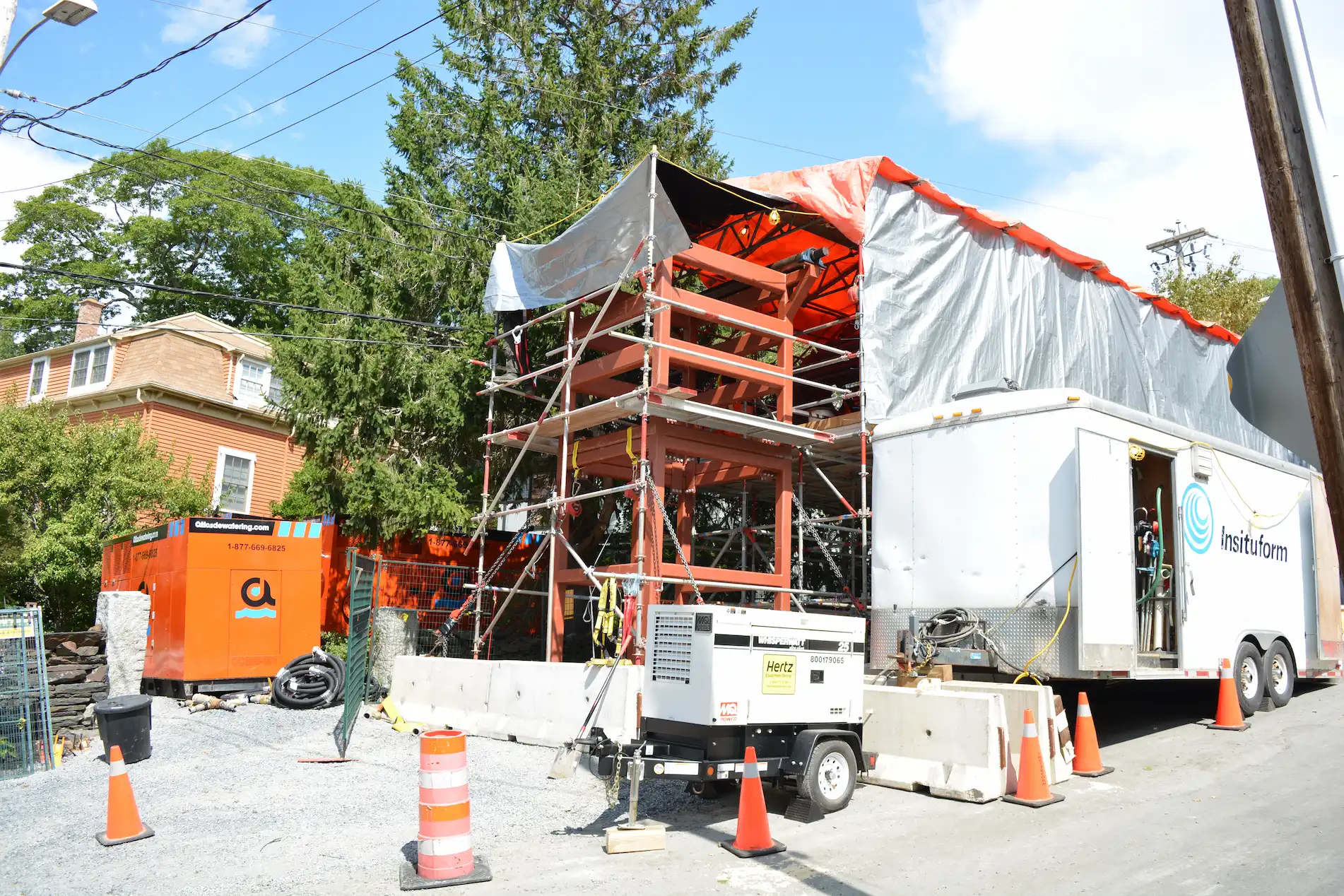
This project is widely considered the most complicated CIPP project completed in Canada and one of the most challenging CIPP projects completed in North America, setting a record for the longest CIPP installation in Canada at 682m.
Engineering Innovation
The design of the CIPP liner required a unique design since CIPP design standards (ASTM F1216) are founded on the basis that the sewer being rehabilitated is circular in shape and is not applicable for non-circular sewers. As a result, the project required the use of a unique design approach, including development of a specialized non-circular design calculation for the arch shaped portions of the sewer. The design approach assessed the pipe in three distinct components, the arch top, the vertical sides, and the dished bottom. The design parameters for each of these individual components were established, along with design equations to identify the CIPP thickness required to meet the expected loads.
Coordination with Stakeholders
 The NATS project involved significant co-ordination efforts with several agencies including CN, local municipalities, Parks Canada, and private property owners, as the work was predominantly completed on private property. This was accomplished through a comprehensive communication plan and multi modal communications (e.g., web site, community meetings, individual property owner meetings, etc.). The project further required multi disciplines to be involved, including coastal engineers (tidal impacts on pipe), mechanical engineers (PS retro fit), civil engineers for construction of access maintenance holes, CCTV contractor, etc. This required sound co-ordination in order to complete the project engineering in a very short time period.
The NATS project involved significant co-ordination efforts with several agencies including CN, local municipalities, Parks Canada, and private property owners, as the work was predominantly completed on private property. This was accomplished through a comprehensive communication plan and multi modal communications (e.g., web site, community meetings, individual property owner meetings, etc.). The project further required multi disciplines to be involved, including coastal engineers (tidal impacts on pipe), mechanical engineers (PS retro fit), civil engineers for construction of access maintenance holes, CCTV contractor, etc. This required sound co-ordination in order to complete the project engineering in a very short time period.
Located on the coast of the Northwest Arm body of water, the NATS alignment meanders along the shoreline and ranges in distances of anywhere from 0-10 meters from the water’s edge. The 4.7km shoreline that the sewer runs parallel to has a variety of difficult to access terrain including multimillion dollar residences, steep shoreline slopes, limited access due to load bearing bridges (only minor loads permitted), CN Rail track crossings, hydro permits, etc. Robinson Consultants Inc. completed a feasibility study which included review of permit requirements and consultation with numerous agencies/stakeholders including CN Rail, Nova Scotia Hydro, Parks Canada, Halifax Municipality, Halifax Harbour Port Authority, and Nova Scotia Environmental.
Robinson Consultants Inc. corresponded with the public regarding the bypass installations or potential service disruption that might occur. Phase 1 of the project also involved a review of access constraints along the project limits and the initiation of required permit applications. Robinson Consultants Inc. communicated with over a hundred property owners along the project easement. The communications were conducted through two public meetings, mail notices, conference calls, and on-site visits. Also, an ‘Underground Overhaul’ page was built on Halifax Water’s website that gave residents timely updates on the project, with signs posted along the project route and QR codes linking to the website. Communication in every practical way was undertaken to express the project need and benefits of the rehabilitation technology method. This resulted in significant public support with only minor issues raised during construction, in fact, some owners where very helpful in executing the work.
CN Rail engagement was required to address the load restricted bridges which need to be crossed to transport materials and equipment to site. Significant co-ordination with CN Rail produced new structural load assessments for each bridge (five total) to determine the exact safe load limits which could be transported across. These limits where used in the constructability assessment and described in the RFP for contractors. This result in a construable solution being implemented which observed the require bridge load limits.
Parks Canada was engaged due to the final installation location requiring transportation of equipment and materials through Federal Park land (Point Pleasant Park). This included the assessment of the interior park roads to determine if the required trucks could safely travel on the roads. In addition, a tree trimming plan was developed along the interior roads to allow for the truck movement without damaging vegetation. This engagement allowed for very large truck movement through the park without any significant disruption to vegetation or the public’s use of the park.
Fletcher’s Creek Trunk Sewer Rehabilitation Project
Project Description
Robinson Consultants Inc. was retained by the Region of Peel to complete the detailed condition assessment, detailed design (including supporting preliminary and technical reviews, memos and studies), and contract administration and site inspection for the rehabilitation of the Fletcher’s Creek Sanitary Trunk Sewer. Project scope included 41 maintenance hole to maintenance hole segments, approximately 4km of 750mm, 975mm, and 1200mm in diameter at an average depth of 8-10m. The project also included the rehabilitation of maintenance holes and appurtenances for Fletcher’s Meadows within the City of Brampton.
The 2013 and 2017 detailed condition assessment of the Fletcher’s Creek Sanitary Trunk Sewer, conducted by the Region of Peel, revealed that several locations of the sewer were in poor condition, with longitudinal fractures and heavy infiltration, as well as several maintenance holes requiring rehabilitation. The design phase included the recommendation for the identified sewer sections with structural and service deficiencies for rehabilitation with a combination of CIPP lining and mechanical seals. Recommendations for maintenance holes included elimination of infiltration via chemical grouting, replacement of ladders and platforms to comply with Region of Peel standards and repair interior appurtenances as required.
Robinson Consultants Inc. also assisted with the pre-construction and construction phases on the project involving working with the Region of Peel’s procurement team on the preparation of a Request for Proposal (RFP) including evaluation criteria, technical specifications, and engineering drawings to select a successful contractor for construction. contract administration, site inspection, and quality control services were completed during construction.
Engineering Innovation
Due to the overall size and complexities of the project, the Region of Peel required a strong procurement document that allowed for a fair bid process, which clearly articulated Region’s requirements. It was crucial that the document also ensured that the selected Contractor was qualified to complete the project and had proposed a sound, detailed approach and methodology. The document had a strong focus on the overall project deliverables, evaluation criteria, and rigorous technical specifications for QA/QC throughout the project.
Robinson Consultants Inc. investigated the implications of ground water on the various CIPP curing methods along with limitations and included the requirement for hot water cure only for applicable segments with high groundwater table and longer installation shots. The specification also required the utilization of a dual temperature monitoring system along the invert, in addition to standard temperature monitoring at the maintenance holes. This provided stronger accountability on the contractor to install compliant CIPP liners through recordable evidence of a fully cured CIPP liner.
Four sewer segments were attempted to be CIPP lined in 2005 but initially failed likely due to excessive groundwater pressure experienced during installation and curing. This required installation of a second liner over the existing liners shortly after the first liner was installed. In order to eliminate the greater risk of a Contractor’s inability to stop groundwater infiltration in advance of liner installation, the requirement to eliminate gushing infiltration by installing mechanical seals was included in the RFP. This greatly reduced the risk of chemical grouting not providing sufficient resistance to hydrostatic pressure exerted during liner installation and curing.
Public Consultation and Stakeholder Engagement
A majority of the sewer segments are located within the Fletcher’s Creek Floodplains with access maintenance holes located in proximity to the Creek. Fletcher’s Creek is home to Redside Dace which is an endangered species with its habitat protected under the Endangered Species Act. Excavation activity associated with construction of a temporary access road within the Floodplains of Fletcher’s Creek would have required extensive permitting from the Ministry of the Environment, Conservation, and Parks (MECP). In order to minimize disturbance to the habitat, Robinson Consultants Inc. identified the ability to utilize temporary wood matting over existing trails and grassed areas and specified this as part of RFP requirements. This approach was review by the Credit Valley Conservation (CVC) and MECP and resulted in eliminating the need for additional permitting allowing the execution of the critical phase of the project on time with minimal disturbance to the surrounding thus protecting the environment.
Further stakeholder co-ordination was required with the City of Brampton, including City Parks and City Traffic groups. This co-ordination was a key to the success of the project to ensure appropriate notifications and scheduling for the closure of the public path through the park and both road closures and lane restriction during construction.
In the News
Challenging Trunk Sewer Condition Assessment and Rehabilitation Initiatives in the Region of Peel
Woodroffe Avenue Watermain Replacement
Project Description
This project was initiated in response to a large watermain break in 2011 on the primary water supply to the south end of Ottawa. Robinson Consultants Inc. was retained by the City of Ottawa to complete a condition assessment and risk analysis to determine the optimal renewal strategy. The project included the design and construction of 1km of 1220mm watermain, 400m of 305mm watermain by directional drilling, a mobile pump station and temporary bypass pipe, three individual spot repairs, pipe material selection, corrosion protection, wire break monitoring system, tender package, construction staging and watermain commissioning plan, full traffic bypass plans for short term closures of Hunt Club Road, public communications and construction administration and inspection.
The Woodroffe Avenue watermain is a 1220mm transmission watermain that is the primarily supply for Barrhaven, Riverside South and the Village of Manotick, serving a population of approximately 100,000 people. Following the break and subsequent electromagnetic inspection, it was determined that 1km of the watermain had to be replaced. While this watermain was isolated for inspection and replacement, the area was being serviced by a 406mm watermain and booster pump. Since the 406mm watermain could not provide adequate supply for peak-summer demands, an outdoor water ban was implemented by the City. Robinson Consultants Inc. fast-tracked the design and tender package to limit the amount of time that this critical watermain was out of service, as well as the length of the outdoor water ban.
In an effort to add additional supply to the isolated section of 1220mm south of the replacement section, a 305mm watermain was constructed by horizontal directional drilling and open-cut methods. The 305mm watermain was connected to an existing 610mm C301(L) PCCP at the north and to the 1220mm C301(L) at the south. Both of these connections were made using a live taps.
A 1km section of 1220mm C301(L) PCCP watermain was replaced within the project limits. This watermain replacement included new valves and valve chambers, hydrants where required and large services to the Nepean Sportsplex. The watermain design included a full cathodic protection design, including coordination with PURE Technologies for the installation of an acoustic fiber optic cable within the watermain, which is used to record prestress wire breaks in real time. Spot repairs were completed at three other locations, where the initial inspection had identified additional distressed pipes.
Stamford Interceptor Trunk Sewer Phase II Rehabilitation
Project Description
Robinson Consultants Inc. was retained by Niagara Region to complete the rehabilitation planning, preliminary design, and detailed design for the Stamford Interceptor Trunk Sewer Rehabilitation Phase II. Niagara Region identified the need to rehabilitate the Stamford Interceptor Trunk Sewer (SITS) in the City of Niagara Falls based on historical CCTV inspections which showed that the segments are in very poor condition based on severe corrosion and exposed reinforcement as a result of hydrogen sulfide (H2S) in the pipe. The project scope included Phase II of the trunk sewer consisting of 1560m of 1050mm diameter reinforced concrete pipe, composed of 14 segments and 14 maintenance holes. The SITS runs parallel to the Ontario Power Generation (OPG) canal and along the new high traffic pedestrian trail (Millennium Recreational Trail). The objective of the project was to rehabilitate Phase II of the SITS and the associated maintenance holes using trenchless technology. As part of the trunk sewer rehabilitation project, the Region’s intention was to minimize disruption and closure of the Millennium Recreational Trail to reduce inconvenience to the public as well as reduce potential impacts to the existing OPG lands during construction.
Based on an evaluation of the potential trenchless rehabilitation options for the SITS, it was recommended that the Region proceed with the use of Cured-in-Place Pipe (CIPP) to rehabilitate the sewer due to its capability to resist H2S corrosion, provide a fully structural rehabilitation solution, and minimize impacts to flow capacity, and its suitability for 1050mm diameter pipe and commercial availability in the local market. Extensive coordination required during the design phase in order to minimize disruption and closure of the Millennium Recreational Trail to reduce inconvenience to the public as well as reduce potential impacts to the existing OPG lands during construction.
For the procurement process, it was recommended that the Region pursue a Request for Proposal (RFP) process versus a tender due to the complexity of the project, specialty nature of the rehabilitation work and the risks associated with working within the property. The objectives for the RFP are to retain a qualified and experienced rehabilitation contractor with a well-planned approach and methodology to complete the work.
Eight Culvert Replacements
Project Description
Robinson Consultants Inc. was retained by the City of Ottawa to undertake the preliminary and detailed design for the replacement of eight existing culverts. The renewal structures included CSP and concrete round pipe. The culvert replacements were split into five separate contract packages for staggered delivery and construction. The replacement structures size ranged from 600mm to 3000mm in diameter. Trenchless renewal methods were designed for two of the sites using Cured-in-Place (CIPP), HDPE sliplining, and auger boring. One of the culverts failed during the design phase and required a road closure and emergency replacement operation.
Several activities were completed to support the design, including: hydrologic and hydraulic modelling, assessment of trenchless rehabilitation measures, geotechnical study, natural environment study, and consultation with environmental and federal regulatory agencies. Robinson Consultants Inc. completed the preliminary and detailed design including traffic and construction staging plans, temporary flow control, guiderails, and utility protection measures. Robinson Consultants Inc. also prepared tender documents in accordance with the City of Ottawa standards, attended meetings with utility companies, prepared property requirement plans, and obtained the necessary environmental approvals.
Ravensview Trunk Sewer and North End Outlet Rehabilitation
Project Description
Robinson Consultants Inc. was retained by Kingston Utilities to assist in the planning, design, tendering, contact administration, and site inspection of the Ravensview Trunk Sewer (RTS) and North End Outlet (NEO) sanitary sewer rehabilitation project. The RTS/NEO rehabilitation project consisted of several phases completed over a 5-year period. The RTS and NEO are two major trunk sewers situated within the City of Kingston ranging in diameters sizes of 750mm to 1350mm with total combined length of 6km. The NEO runs predominately off road through wood areas and parks, and the RTS runs through wood areas in close proximity to Lake Ontario, behind some large private properties and through the Canadian Forces Base (CFB) Kingston and out letting to the Ravensview Wastewater Treatment Plant (WWTP).
The RTS and NEO were identified as having moderate to severe H2S corrosion deterioration throughout their lengths, including exposed rebar. Project activities included sewer condition assessment, trenchless rehabilitation methodology recommendations, establishing priorities areas for rehabilitation, physical condition investigations (core sampling, H2S corrosion assessment), geotechnical investigations, failure risk analysis, emergency responses plan, flow by-pass planning for 2350 L/s flows (RTS) & 770 L/s, preparing cost estimates and schedules, significant stakeholder meetings including Department of National Defense, preparing technical specifications, bid forms and price schedule, development of contractor RFP (including evaluation criteria), evaluation of RFP responses, technical QA/QC review of CIPP liner sampling and training seminars.
Condition assessment included recommendation on priority work for phasing of the rehabilitation work over 5 years to maximize the available capital funding per calendar year while mitigating risk. A key consideration in design and specification included flow control/bypass requirements made challenging by high flow rate forcemains incoming directly into the sewer at the rehabilitation.
RTS required a 2350 l/s fully operational flow by-pass system to be set-up and in operation for duration of project. This was accomplished through the innovative design and construction of a temporary wet well to capture and by-pass pump the flows.
Potential rehabilitation methods were analyzed resulting in selecting CIPP lining due to availability of several contractors to perform the work along with the installation method being best suited to the pipe and site conditions along with capacity requirements.
Contract administration and inspection services for the CIPP lining of this major trunk sanitary sewer included major bypass pumping, emergency preparedness, and coordination with multiple landowners including CFB Kingston.
This critical piece of Kingston infrastructure was built in the 1950s and conveys 60%-70% of Kingston sewer flow including downtown and east end. The project limits started at Hwy 2 and Hwy 15 and ran through CFB Kingston, Cartwright Point, and La Salle Blvd and outlets at the Ravensview Treatment Plant.
The 3.4km of 1200mm and 1350mm pipe was rehabilitated. The main key to success with a project as complicated and involved as this was a team-based approach involving all stakeholders, which resulted in an effective approach to maintaining construction schedule and pre-empting issues that would cause delays and conflicts.




